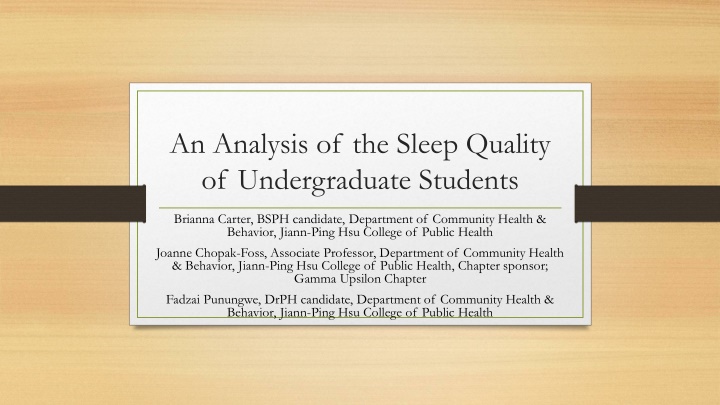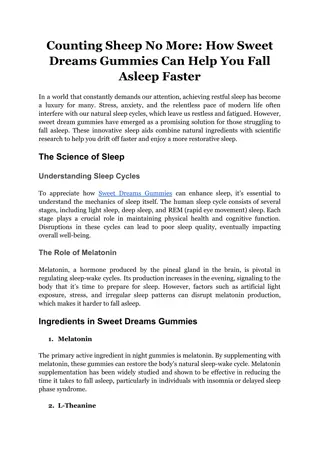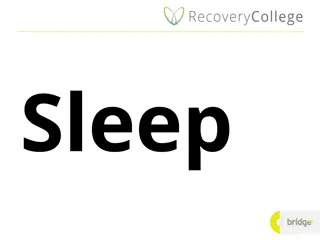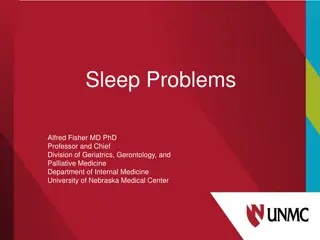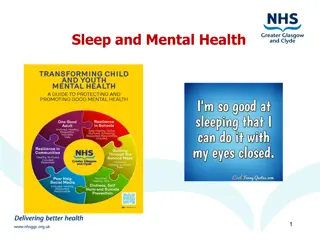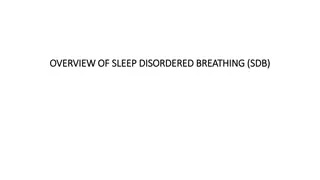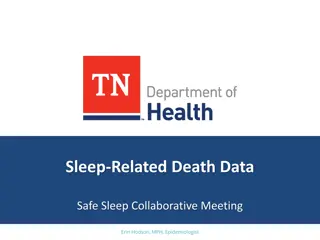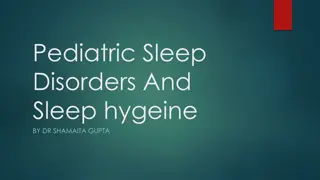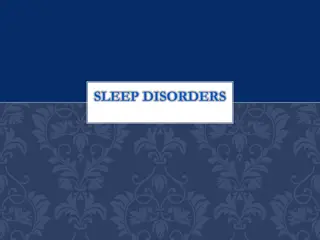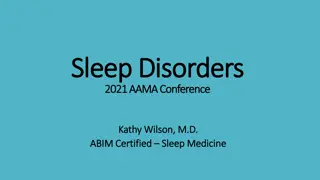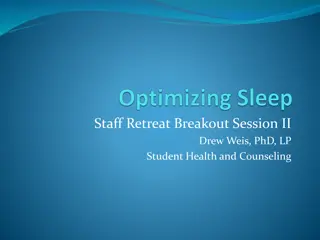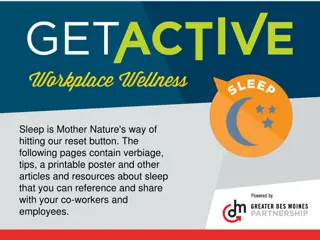Analysis of Undergraduate Students' Sleep Quality
This study examines the sleep quality of undergraduate students, highlighting the impact of sleep deprivation on academic performance and overall well-being. The research explores the prevalence of insufficient sleep among college students and its association with various health issues. Methods employed include a descriptive, cross-sectional design utilizing Qualtrics survey software. Participants were recruited through flyers, Facebook, and email, with a focus on assessing sleep patterns and comparing them to recommended guidelines. The findings shed light on the sleep habits of young adults in an academic setting.
Download Presentation

Please find below an Image/Link to download the presentation.
The content on the website is provided AS IS for your information and personal use only. It may not be sold, licensed, or shared on other websites without obtaining consent from the author.If you encounter any issues during the download, it is possible that the publisher has removed the file from their server.
You are allowed to download the files provided on this website for personal or commercial use, subject to the condition that they are used lawfully. All files are the property of their respective owners.
The content on the website is provided AS IS for your information and personal use only. It may not be sold, licensed, or shared on other websites without obtaining consent from the author.
E N D
Presentation Transcript
An Analysis of the Sleep Quality of Undergraduate Students Brianna Carter, BSPH candidate, Department of Community Health & Behavior, Jiann-Ping Hsu College of Public Health Joanne Chopak-Foss, Associate Professor, Department of Community Health & Behavior, Jiann-Ping Hsu College of Public Health, Chapter sponsor; Gamma Upsilon Chapter Fadzai Punungwe, DrPH candidate, Department of Community Health & Behavior, Jiann-Ping Hsu College of Public Health
Background Sleep is necessary to fight off infection, support the metabolism, perform well in school, and be effective at work (U.S. Department of Health and Human Services, 2013). Studies have shown that sleep plays a critical role in immune function, metabolism, memory, learning, and other vital functions (Ganz, 2012; Harvard Medical School, 2008; Kronholm, et al., 2009; Lo, Dijk, Groeger, 2014; Morseli, Guyon & Spiegel, 2012;Yang et al., 2014).
Background Continued College students are at high risk for not getting enough sleep. According to the National Sleep Foundation, college students can need up to 8.5 to 9.5 (National Sleep Foundation, 2014). However, Orzech, Salafsky, and Hamilton (2011) reported daily hours of sleep below the recommended hours. Forquer, Camden, Gabriau and Johnson (2008) report: Experienced frequent night waking, short sleep time, long sleep latencies, and a disrupted circadian rhythm due to later bedtimes and wake times on the weekends than weekdays
Problem and Purpose For college students, sleep deprivation and poor quality sleep has been linked to GPA, academic performance, and learning capabilities. Linked to depression (Garlow 2008), substance abuse (Singleton & Wolfson, 2009) , and prescription drug abuse ((Arria, 2011) The purpose of this study was to measure the sleep quality of a sample of undergraduate students and compare it to the recommendations for young adults from the National Sleep Foundation.
Methods Descriptive, cross-sectional design Qualtrics survey software The sampling methodology employed was a nonprobability, sample of convenience. Participants were recruited through: flyers, Facebook, and email.
Participants 105 students Only 86 completed the survey The sample was overrepresented by females (80% & 20%) Age range: 18 27 years. A total of 50% of the students were Caucasians/White, 44% were Black/African American 6% identified themselves as other. The majority of the respondents were seniors (40%), followed by juniors (24%), sophomores (22%), and freshmen (14%)
Results The mean PSQI score for the sample (N=58) was 9.47. 8% reported their sleep quality as very good was 8% compared to 63% rated their sleep quality as fairly good . 28% of the respondents rated their sleep quality as fairly bad . Half of the students (51.2%) reported getting under 7 hours per night, Only 8.1% reported sleeping 8.5 hours or longer. The average number of minutes it took to fall asleep 36.37 minutes.
Results Continued Significant correlations were found for the following variables sleep disturbance and sleep efficiency, sleep latency and sleep duration needing medication to sleep and overall sleep quality sleep duration and overall sleep quality
Discussion The results of the study showed that there was a disconnect between the students perceptions of their overall quality of sleep and the global score of the PSQI. A total of 70% of the students reported having very good to fairly good sleep quality which is similar to the results found by Orzech et al. (2011). However, the mean PSQI score in this study indicated that the students had poor sleep quality.
Discussion Continued Predictably, the undergraduate students reported getting fewer than seven hours of sleep over the past month (51%), which is higher than the results of Lund and colleagues (2010) These students had less than the 8.5 - 9.5 hours of recommended sleep each night for college students to function at their best (National Sleep Foundation, 2014). Sleep duration can be a predictor of one s health status. Diabetes, obesity, hypertension, cardiovascular disease, etc ((Altman et al, 2012; Najafian et al., 2013)
Limitations Small non-randomized sample size (N=86) was obtained. Larger proportion of females, seniors, and a narrow range of racial and ethnic differences. Listwise deletion method was used to account for the missing data to allow comparisons across the variables using the nonparametric correlations. Made the sample size analyzed even smaller. Results from the study could not be generalized to the larger undergraduate population.
Recommendations The study found similar results to other large-scale studies which used the PSQI instrument to examine the sleep quality in college students (Gaultney, 2010; Orzech, 2011). Employing a mixed-methods approach The use of incentives might help boost response rates. Examining the relationship of sleep quality among undergraduate students at different points of time in the academic school year
References Altman, N., Izci-Balserak, B., Schopfer, E., Jackson, N., Rattanaumpawan, P., Gehrman, P., & Grandner, M. (n.d). Sleep duration versus sleep insufficiency as predictors of cardiometabolic health outcomes. Sleep Medicine, 13(10), 1261-1270. Arria, A., Caldeira, K., Kasperski, S., O'Grady, K., Vincent, K., Griffiths, R., & Wish, E. (2010). Increased alcohol consumption, nonmedical prescription drug use, and illicit drug use are associated with energy drink consumption among college students. Journal of Addiction Medicine, 4(2), 74-80. doi:10.1097/ADM.0b013e3181aa8dd4 Forquer, L. M., Camden, A. E., Gabriau, K. M., & Johnson, C. (2008). Sleep Patterns of College Students at a Public University. Journal of American College Health, 56(5), 563-565. Ganz, F. (2012). Sleep and Immune Function. Critical Care Nurse (32(2), e19-e25. Doi:10.4037/ccn2012689 Garlow, S. B. (2008). Depression, desperation, and suicidal ideation in college students: results from the American Foundation for Suicide Prevention College Screening Project at Emory University. Depression & Anxiety (1091-4269), 25(6), 482-488. Gaultney, J. F. (2010). The Prevalence of Sleep Disorders in College Students: Impact on Academic Performance. Journal of American College Health, 59(2), 91-97. Harvard Medical School. (2008). Benefits of sleep. Retrieved from http://healthysleep.med.harvard.edu/healthy/matters/benefits-of-sleep Kronholm, E., Sallinen, M., Suutama, T., Sulkava, R., Era, P., & Partnonen, T. (2009). Self-reported sleep duration and cognitive functioning in the general population. Journal of Sleep Research, 18(4), 436-446. Doi:10.1111/j.1365-2869.2009.00765.x Lo, J.C., Dijk, D., & Groeger, J.A. (2014). Comparing the Effects of Nocturnal Sleep and Daytime Napping on Declarative Memory Consolidation. Plos ONE, 9(9), 1-5. Doi:10.1371/journal.pone.0108100 Lund, H. G., Reider, B. D., Whiting, A. B., & Prichard, J. R. (2010). Sleep patterns and predictors of disturbed sleep in a large population of college students. Journal of adolescent health, 46(2), 124-132. Morselli L, Leproult R, Balbo M, Spiegel K. Role of sleep duration in the regulation of glucose metabolism and appetite. Best Practice Research in Clinical Endocrinology Metabolism. 2010;24:687 702. National Sleep Foundation. (2014). NSF S key messages. Retrieved from http://sleepfoundation.org/sites/default/files/Drowsy%20Driving- Key%20Messages%20and%20Talking%20Points.pd Orzech, K. M., Salafsky, D. B., & Hamilton, L. (2011). The state of sleep Among college students at a large public university. Journal of American College Health, 59(7), 612-619. doi:10.1080/07448481.2010.520051 Najafian J, Mohamadifard N, Siadat ZD, Sadri G, Rahmati MR. 2013. Association between sleep duration and diabetes mellitus: Isfahan Healthy Heart Program. Niger J Clin Pract 16: 59 62. Singleton, R.A.,& Wolfson, AR. (2009). Alcohol consumption, sleep, and academic performance among college students. Journal of Studies on Alcohol and Drugs, 70:355 363 U.S. Department of Health and Human Services. (2013, April 10). Sleep health. Retrieved from http://www.healthypeople.gov/2020/topicsobjectives2020/overview.aspx?topicid=38 Yang, G., Lai, C., Cichon, J., Ma, L., Li, W., & Gan, W. (2014). Sleep promotes branch-specific formation of dendritic spines after learning. Science, (6188), 1173.
